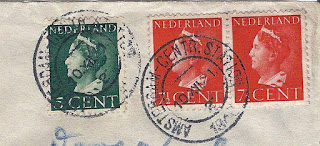 |
| Postcard from Haarlem to Alkmaar, sent on the 9th of August 1920 |
At first sight a very ordinary postcard with an equal ordinary message: congratulations for somebody's birthday. One element on this card struck me though: the dashed upper line of the machine postmark. I hadn't seen this before. We will take a closer look:
 |
| Haarlem Krag machine cancel on Wilhelmina Fur Collar 5 ct stamp |
As is clear from the scan, the upper line of the postmark's strike seems inconsistent compared to the other three. What caused the machine to create this mysterious dashed line? Before we can answer this question, we should first dive deeper in the mechanics of the Norwegian Krag postmarking device. In 1904 E. G. Lannge described the mechanism of the machine:
"After letters or cards have been placed upright in a duct, they are moved by a sliding block (or by hand) towards the lower edge of the duct. There they are caught hold of, one by one, by rubber-coated cylinders that lead them between two cylinders rotating very close to each other. On one of these the postmarks are engraved. The postmark cylinder received color from an inking cylinder located behind it. From the postmark cylinder the mail was led through a series of wheels, arranged in spiral pattern, which brought in to a horizontal duct where a counterweight held them upright."
So, if I have read Mr Lannge's description correctly, my item was pushed by two rubber-coated cylinders in a narrow duct in order to get the postmark printed on the piece. The actual Haarlem cancel together with the four lines was thus engraved on one of these cylinders. But how did one of these lines became so fractured?
Could it be that the upper line was obstructed by a piece of rubber, which could have created the dashed effect? If this would have been the case, I reckon the machine would have stopped immediately in order to save the postal items and the machine itself. Or did a rubber in the 'series of wheels' dot the still wet ink after the piece was postmarked? Or did the postmarking cylinder just reached its expiration date because of worn? Or...
A very sharp-eyed philatelist on Stampboards.com eventually found out what's really caused the dotted-line. The lower part of the actual 'Haarlem' postmarks hasn't been printed at all, so the ink roller would have probably been installed too high, which made a part of the cancel roller visible not intended to be seen (the dotted band). At the same time, the lower parts of the cancel roller missed the ink roller, which caused the split postmark and the absence of the bottom line.
In my following blog I will tell you more about the contents, route and hopefully more about the sender and addressee of this postcard.

















